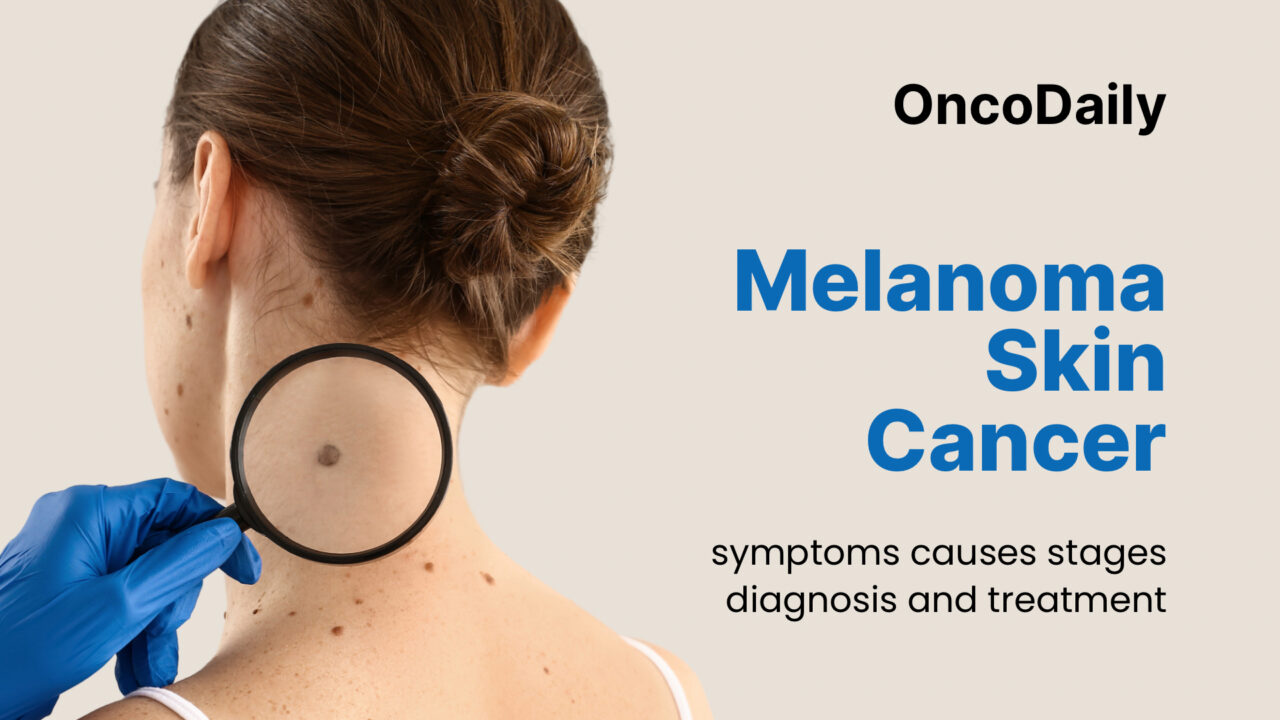Ocular melanoma is a rare but serious type of cancer that arises from melanocytes within the eye. It is the most common primary intraocular malignancy in adults and the second most prevalent melanoma after cutaneous melanoma. Accounting for 3% to 5% of all melanomas, ocular melanoma typically originates in the uveal tract, which comprises the iris, ciliary body, and choroid. The majority of cases arise from the choroid or ciliary body, with a median diagnosis age of 62, most frequently occurring between the ages of 70 and 79.
In 2025, the American Cancer Society estimates that around 3,140 new cases of eye and orbit cancer will be diagnosed in the United States, with approximately 1,620 cases in men and 1,520 in women. About 490 people—270 men and 220 women—are expected to die from these cancers.
Types of Ocular Melanoma
Ocular melanoma is classified based on the part of the eye where the tumor originates. The most common and well-studied form is uveal melanoma. Less commonly, melanoma can develop on the conjunctiva, the transparent membrane covering the white of the eye.
Uveal Melanoma
Uveal melanoma is the most common type of ocular melanoma, accounting for about 85–90% of all cases. It originates from melanocytes within the uveal tract, which includes the iris, ciliary body, and choroid. Though it is a rare cancer overall, uveal melanoma is the leading primary intraocular malignancy in adults. Due to its location inside the eye, it often develops without early symptoms, making routine eye exams essential for early detection and timely treatment.
Choroidal melanoma is the most frequent subtype. It originates from melanocytes in the choroid, the vascular layer beneath the retina. Because it grows behind the eye, it often goes unnoticed until it begins to affect vision. Symptoms may include blurred vision, floaters, or visual field defects, but in many cases, it’s discovered incidentally during routine eye exams. Without early detection, the tumor can grow extensively before becoming symptomatic.
Ciliary body melanoma arises from the ciliary body, which lies between the iris and the choroid. Though less common (about 5–8% of uveal melanomas), it is more aggressive and often diagnosed at a more advanced stage. Its hidden location delays detection, and by the time it’s discovered, it may have already caused significant eye distortion or spread beyond the sclera.
Iris melanoma, comprising about 3–5% of cases, is usually the least aggressive form. It tends to grow slowly and is more likely to be noticed early, as it can cause visible changes in the eye. Patients may notice a dark spot on the iris, a change in eye color, or an irregular pupil shape. Despite its typically indolent behavior, some cases may still invade deeper ocular structures or metastasize.
Conjunctival Melanoma
Although conjunctival melanoma is much rarer than uveal melanoma, it is often more aggressive. It originates on the surface of the eye and presents as a pigmented or non-pigmented lesion on the conjunctiva. Unlike uveal melanoma, conjunctival melanoma is more similar to cutaneous (skin) melanoma in both appearance and genetic profile. It tends to recur locally and carries a higher risk of regional lymph node involvement and distant metastases. Early diagnosis and wide surgical excision are crucial to improve outcomes.
Histological Subtypes
Ocular melanomas are categorized into three main histological cell types:
- Spindle cells are elongated and typically linked to a more favorable prognosis. These cells are less likely to exhibit aggressive behavior, leading to a better long-term outcome for patients with tumors composed predominantly of spindle cells.
- Epithelioid cells are larger, rounder, and show more atypical characteristics. Tumors composed mostly of epithelioid cells tend to be more aggressive, often leading to faster growth and a higher likelihood of metastasis, which correlates with a poorer prognosis.
- Mixed cell type tumors contain both spindle and epithelioid cells and are the most common subtype. The presence of both cell types can contribute to a range of clinical outcomes, depending on the proportion of each cell type and the overall aggressiveness of the tumor.
Risk Factors of Ocular Melanoma
Uveal melanoma develops due to a combination of genetic, environmental, and individual factors. One of the most recognized clinical risk indicators is the presence of choroidal nevi, especially when these show features like a thickness greater than 2 mm or proximity to the optic nerve. Ocular or oculodermal melanocytosis, along with light-colored eyes, fair skin, and a history of frequent sunburns, are also associated with a higher likelihood of developing the disease.
Family history and Genetic Factors
Familial predisposition plays a role in a minority of cases, but it’s significant. Germline mutations in genes such as BAP1, PALB2, and MBD4 are increasingly recognized in familial uveal melanoma. For instance, individuals with BAP1 tumor predisposition syndrome have a heightened risk not only of uveal melanoma but also of mesothelioma, renal cell carcinoma, and cutaneous melanoma. These cases often present at a younger age, involve larger tumors in the ciliary body, and follow a more aggressive course. While PALB2 and MBD4 mutations have also been found in some familial cases, their exact role in uveal melanoma risk is still under investigation.
On a molecular level, mutations in GNAQ and GNA11 are detected in up to 93% of uveal melanomas. BAP1 loss is linked with a higher risk of metastasis and poor outcomes. Conversely, EIF1AX mutations are associated with a better prognosis, while SF3B1 mutations suggest a delayed onset of metastasis.
Unlike uveal melanoma, conjunctival melanoma shares genetic similarities with skin melanoma, often featuring TERT promoter, NRAS, and NF1 mutations. The possible relationship between BRCA2 mutations and ocular melanoma remains under active investigation.
Environmental factors
Though the link between UV radiation and uveal melanoma is less clear than in cutaneous melanoma, prolonged sun exposure without adequate eye protection may still contribute. Other potential risk factors include exposure to welding equipment, chemical irritants, immunosuppression, and smoking.

Learn more about Melanoma (Skin Cancer): Symptoms, Causes, Stages, Diagnosis and Treatment on OncoDaily.
Symptoms of Ocular Melanoma
Ocular melanoma symptoms often appear late, contributing to delayed diagnosis. As tumors enlarge, they may cause blurred or distorted vision, floaters, or flashes of light. Some patients notice a dark spot on the iris or a change in pupil shape. Advanced cases can lead to partial or complete vision loss. Though typically painless, some individuals may experience discomfort or redness if intraocular pressure increases.
Because many cases are asymptomatic in the early stages, routine eye exams play a crucial role in early detection and successful treatment.
Diagnosis of Ocular Melanoma
The diagnostic process for uveal melanoma relies heavily on clinical evaluation. Fundus examination and ocular ultrasound are cornerstone tools, particularly when the tumor is larger than 2 mm or exhibits features like subretinal fluid or ultrasound hollowness.
Comprehensive Eye Exam
A thorough eye examination remains the cornerstone of ocular melanoma diagnosis. During a comprehensive eye exam, ophthalmologists utilize a combination of Biomicroscopy (also known as slit-lamp examination) and indirect ophthalmoscopy to assess the internal structures of the eye. These tools are especially effective in identifying choroidal melanomas, which are the most common type of intraocular melanoma. These tumors often appear as dome-shaped or collar-button lesions with varying pigmentation, and they may be accompanied by orange pigment or subretinal fluid.
However, tumors located in the ciliary body—the part of the eye between the iris and choroid—are more difficult to detect due to their hidden location behind the iris. In these cases, additional imaging and a high degree of clinical suspicion are often required for diagnosis. Symptoms such as blurred vision, eye pain, or a change in pupil shape may be the only clues prompting further investigation.
Color Fundus Photography
As part of the diagnostic workup, color fundus photography plays a vital role in documenting the appearance of intraocular lesions. High-resolution images of the retina and underlying structures help capture key features such as the lesion’s size, shape, pigmentation, and the presence of orange pigment, which can be a sign of lipofuscin—a marker suggestive of malignancy.
Although fundus photography is a valuable tool for monitoring lesion progression over time, it does not typically offer a definitive diagnosis on its own.
Ocular Ultrasound
Highly accurate for diagnosing choroidal melanomas, especially when other exams are limited. It helps assess tumor thickness, extraocular extension, and growth.
- A-Scan: Detects low to medium reflectivity in melanomas and provides tumor measurements.
- B-Scan: Shows hyperchromic masses with low reflectivity, useful for assessing larger tumors and extraocular extension.
Optical Coherence Tomography
OCT is an effective imaging tool for diagnosing uveal melanoma. SD-OCT offers detailed views of the retina and RPE, identifying changes more typical of choroidal melanoma. It detects subretinal fluid, edema, lipofuscin, and degeneration, which are more common in melanomas. While its sensitivity compared to standard exams is debated, OCT helps distinguish melanomas from other lesions like nevi and metastases. EDI-OCT is useful for small lesions, and OCT-A can differentiate melanoma from nevi based on vascular characteristics. OCT provides better anterior segment resolution than ultrasound, though ultrasound is superior for posterior margin visualization.
Fundus autofluorescence
Fundus autofluorescence aids in diagnosing uveal melanomas by highlighting hyperautofluorescence, particularly with tumor pigmentation and RPE disruption. Orange pigment is the most prominent feature. It can also detect drusen and fibrous metaplasia, with varying fluorescence. Autofluorescence helps distinguish orange pigment from drusen but shows hypofluorescence in melanocytomas. Its ability to improve orange pigment detection over standard exams remains uncertain.
MRI
For deeper evaluation, MRI is preferred for assessing extrascleral extension and local spread. PET-CT scans are used to detect distant metastasis, especially in the liver, which is the most common site. Abnormal liver function tests can also prompt further imaging.
Genetic testing of the tumor provides critical prognostic insights. For instance, BAP1 mutations predict high metastatic risk, while EIF1AX mutations are linked to better outcomes.
Stages of Ocular Melanoma
Ocular melanoma staging is based on tumor size, lymph node involvement, and the presence of distant metastasis, each crucial for guiding treatment decisions.
In Stage I, the tumor is small, categorized as T1. This tumor may be further classified as T1a, which refers to a small tumor without involvement of the ciliary body or extraocular extension; T1b, a small tumor with ciliary body involvement; T1c, a small tumor with extraocular extension ≤5 mm but no ciliary body involvement; and T1d, a small tumor with both ciliary body involvement and extraocular extension ≤5 mm. These tumors are confined to the eye, and no regional lymph nodes (N0) or distant metastases (M0) are present.
Stage II is separated into Stage IIA and Stage IIB. Stage IIA is characterized by T1 tumors with more significant features, such as ciliary body involvement or extraocular extension up to 5 mm, categorized from T1b to T1d, still without regional lymph node involvement (N0) or distant metastasis (M0).
Stage IIB involves slightly larger tumors, classified as T2. These tumors may be categorized as T2a, which refers to tumors without ciliary body involvement or extraocular extension; T2b, which refers to tumors with ciliary body involvement; T2c, referring to tumors with extraocular extension ≤5 mm but no ciliary body involvement; and T2d, which refers to tumors with both ciliary body involvement and extraocular extension ≤5 mm. These tumors are still localized to the eye, with no regional lymph node involvement (N0) and no distant metastasis (M0).
Stage III is separated into Stage IIIA, III B, IIIC. Stage IIIA represents more advanced tumor sizes, either T2c-d or T3. These tumors can be further classified as T3a, which refers to larger tumors without ciliary body involvement or extraocular extension; T3b, which refers to tumors with ciliary body involvement; T3c, which refers to tumors with extraocular extension ≤5 mm but no ciliary body involvement; and T3d, referring to tumors with both ciliary body involvement and extraocular extension ≤5 mm. At this stage, the tumor may still not involve regional lymph nodes (N0) or distant organs (M0), but the tumor size suggests a higher risk of spread.
Stage IIIB involves even larger tumors, often T3d or T4 tumors. These tumors may be categorized as T4a, referring to large tumors without ciliary body involvement or extraocular extension; T4b, referring to tumors with ciliary body involvement; T4c, referring to tumors with extraocular extension ≤5 mm but no ciliary body involvement; and T4d, which refers to tumors with both ciliary body involvement and extraocular extension ≤5 mm. These tumors may still have no regional lymph node involvement (N0) or distant metastasis (M0).
Stage IIIC indicates the most advanced local tumors, classified as T4e, where the tumor shows extraocular extension greater than 5 mm. These tumors also remain confined to the eye and nearby structures, with no regional lymph node involvement (N0) and no distant spread (M0).
Finally, Stage IV is the most advanced stage, where the tumor has spread either to regional lymph nodes (N1) or distant organs (M1). If the tumor has metastasized, it is classified as M1a, where the largest metastasis is ≤3 cm; M1b, where the largest metastasis is between 3.1–8 cm; or M1c, where the largest metastasis is ≥8.1 cm. At this stage, any tumor size or regional lymph node involvement is considered metastatic (M1), and treatment typically shifts to systemic therapies to address the spread of the disease.
Understanding these stages is crucial for early diagnosis and treatment planning, ensuring the best possible outcomes for patients with ocular melanoma.
Treatment Options for Ocular Melanoma
Treatment strategies focus on controlling tumor growth while preserving vision when possible.
Radiation Therapy
Brachytherapy and charged particle radiation therapy (RT) are effective primary treatments for uveal melanoma, while photon RT and stereotactic RT (SRT) are less commonly used as initial treatments. SRS may be used for large tumors, and photon RT typically serves as an adjunct to surgery.
Plaque Brachytherapy
Iodine-125 plaque brachytherapy is frequently used for primary tumor treatment, showing high rates of tumor regression (98%) and globe preservation (98%). Local failure after brachytherapy occurs in 0–20% of cases, with recurrence often developing within 2 to 4 years. Post-treatment complications include radiation retinopathy, optic neuropathy, maculopathy, and glaucoma. Enucleation due to treatment failure occurs in about 12% of cases within 5 years. Long-term issues like cataracts and vision loss are common.
Particle Beam Radiation Therapy
Particle beam RT (using protons, carbon ions, or helium ions) shows similar or better survival rates than plaque brachytherapy. It offers higher local control and lower enucleation rates, though complications like vitreous hemorrhage and retinal detachment can occur. Tumor regression may continue for up to 5 years post-treatment.
Stereotactic Radiation (SRS)
SRS has shown local failure rates between 2% and 16% and may offer similar effectiveness to other RT modalities, though with a higher risk of complications such as glaucoma and retinal issues. Studies comparing SRS to brachytherapy show comparable local control, but SRS has higher rates of vision loss and other toxicities.
Laser therapies, such as transpupillary thermotherapy (TTT), may be used in conjunction with radiation. TTT uses infrared laser heat to destroy tumor cells but has a higher recurrence rate when used alone.
RT Toxicity Management
Management strategies for RT-related complications include panretinal photocoagulation, local resection, and intravitreal therapies like anti-VEGF agents for macular issues and optic neuropathy.
Surgical Options
Surgery is considered in select cases. Local resection may be performed for accessible tumors, often alongside radiation. Conjunctival melanoma is typically managed with wide excision, cryotherapy, and sometimes plaque brachytherapy to minimize recurrence.
Enucleation has been the standard treatment for uveal melanoma. The COMS trial showed that enucleation has a very low local recurrence rate (~1%), significantly lower than local resection. Local recurrence typically occurs after distant metastasis has developed. Postoperative complications can include pain, hemorrhage, nausea, and other issues. Enucleation involves complete eye removal and normally includes an orbital implant, with both porous and nonporous implants showing similar outcomes.
Systemic Therapies
Various systemic therapies, including immunotherapies, chemotherapies, targeted therapies, and combinations, have been tested for metastatic uveal melanoma. However, most treatments, evaluated primarily in small phase II trials, show limited efficacy, especially when compared to therapies for cutaneous melanoma. Larger trials have not identified any systemic therapies more effective than chemotherapy, except for recent data on Tebentafusp.
Tebentafusp (KIMMTRAK) is currently the only FDA-approved therapy for HLA-A*02:01-positive patients and has demonstrated a survival benefit. It was tested in a large phase III trial, significantly improving overall survival (OS) and progression-free survival (PFS) compared to standard therapies. However, the response rate was low (9%), suggesting it may prolong survival without shrinking tumors. This treatment was generally well-tolerated but can cause cytokine-release syndrome, requiring hospitalization.

Learn more about KIMMTRAK (Tebentafusp) uses in Cancer: Dosages, Indications, Expectations on OncoDaily.
Immunotherapy
Checkpoint immunotherapies like ipilimumab, nivolumab, and their combinations have shown modest promise, with response rates ranging from 6% to 38% in various trials. However, the effectiveness of these treatments remains uncertain, and more comparative studies are needed.

Learn more about Immunotherapy for Melanoma: Types, Success Rate, Side Effects on OncoDaily.
Chemotherapy
Chemotherapy options, including Dacarbazine, Paclitaxel, and Temozolomide, have been tested with poor results. Combination chemotherapies also yielded low response rates, though one study of cisplatin/dacarbazine/vinblastine showed a 20% response rate. It may still be used when disease progresses after immunotherapy.
Target Therapy
Targeted therapies, including tyrosine kinase inhibitors (imatinib, sunitinib) and MEK inhibitors (selumetinib), have shown limited benefit. Given the lack of effective treatments, further research into alternative options is needed.
Prognosis and Outcomes
While local treatments successfully prevent recurrence in 95% of cases, about 50% of patients eventually develop metastasis, usually to the liver. Once metastasized, the median survival is around 10 months. The prognosis worsens with factors such as older age, larger tumors, ciliary body involvement, extrascleral extension, and epithelioid cell histology.

Read about Ocular Side Effects of Chemotherapy: Understanding the Risks of Eye Toxicity on OncoDaily.
Latest Research and Clinical Trials
In recent years, research in ocular melanoma has taken encouraging strides, offering new hope to patients with advanced disease. Beyond Tebentafusp, ongoing clinical trials are evaluating a variety of new treatments and drug combinations.
A Phase 2 study published in JCO (May 29, 2024) evaluated the safety and efficacy of neoadjuvant and adjuvant Darovasertib in patients with localized ocular melanoma. Among 15 patients scheduled for enucleation, neoadjuvant treatment led to significant tumor shrinkage—up to 45% after 6 months—allowing 66% to undergo eye-sparing therapies. Treatment was well tolerated. These findings support Darovasertib as a promising globe-sparing strategy, with larger trials underway (NCT05907954).
The NCT06717126 trial evaluates Roginolisib versus standard treatment in advanced or metastatic uveal melanoma. This Phase II, open-label, randomized study aims to assess overall survival and quality of life. It will enroll 85 patients who have progressed after at least one prior immunotherapy and have measurable disease. Roginolisib will be tested as a monotherapy compared to the investigator’s chosen treatment.
NCT06519266 is a Phase III trial that aims to evaluate progression-free survival in patients with uveal melanoma liver metastases. Participants are randomized to receive either percutaneous hepatic perfusion (PHP) combined with ipilimumab and nivolumab or ipilimumab and nivolumab alone. Uveal melanoma, the most common primary eye cancer in adults, has a high rate of liver metastases, which are resistant to chemotherapy, leading to a median survival of just 6 months. The study also focuses on efficacy, safety, and biomarker discovery.
NCT06121180 is a Phase II study that aims to evaluate the safety and effectiveness of Cemiplimab combined with Ziv-Aflibercept in treating metastatic uveal melanoma. The study will test whether this drug combination can shrink tumors or halt their growth.

You can read about Ocular Side Effects Of Immune Checkpoint Inhibitors on OncoDaily.
Written by Mariam Khachatryan, MD
FAQ
What is the most common type of Ocular Melanoma?
The most common type is uveal melanoma, particularly originating from the choroid, which makes up about 85–90% of cases.
Who is at higher risk of developing ocular melanoma?
People with light-colored eyes, fair skin, and northern European ancestry are at higher risk. Men are slightly more affected than women.
Is ocular melanoma hereditary?
In some cases, yes. Germline mutations like BAP1 can increase familial risk. However, most cases are sporadic.
What are common symptoms of ocular melanoma?
Symptoms may include blurred vision, floaters, a dark spot on the iris, or vision loss—though many cases are asymptomatic early on.
How is ocular melanoma diagnosed?
Diagnosis typically includes fundus examination, ocular ultrasound, OCT, MRI, and sometimes genetic testing of the tumor.
What is the most effective treatment for localized uveal melanoma?
Radiation therapy, especially plaque brachytherapy or proton beam therapy, is often the first-line treatment aimed at preserving the eye.
Are there effective treatments for metastatic ocular melanoma?
Tebentafusp is the only FDA-approved systemic treatment for HLA-A*02:01-positive patients. Other options include clinical trials, immunotherapy, and targeted therapies.
